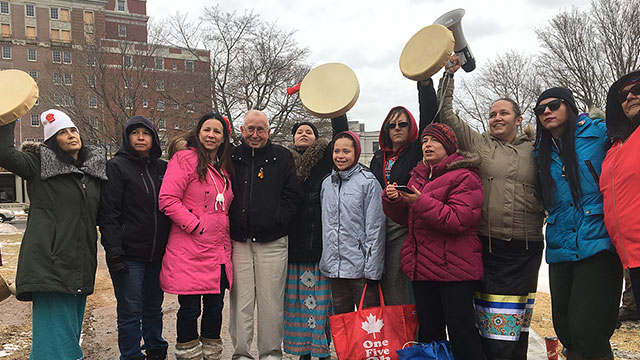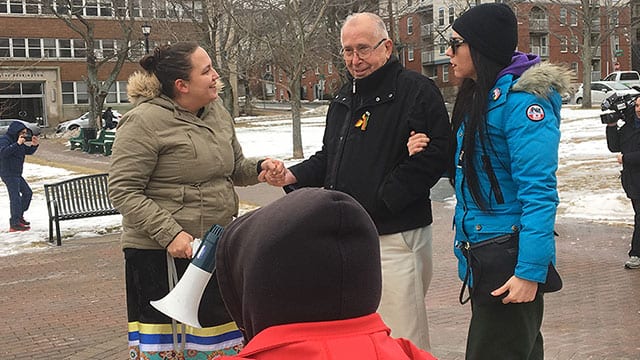Mi’kmaq and allies gathered in ceremony and celebration Sunday in Halifax just days after the statue of Edward Cornwallis was removed.
What was originally planned as a rally to continue efforts to have the statue taken down turned into a drum and smudge ceremony and a celebration of Halifax’s decision to remove the statue indefinitely, pending further review by an expert panel that will determine the statue’s future.
Members of the Mi’kmaq community sang the Mi’kmaq Honour Song, as warriors elders and other grassroots people spoke of the significance of the statue’s removal.
Cornwallis is celebrated by many as the founder of what is now the city of Halifax. But to Mi’kmaq, the former British military leader’s statue was a reminder of the violence perpetrated against them during the early colonial period.
They remember Cornwallis as the man who issued bounties on Mi’kmaq scalps in 1749 and 1750, offering money to those who killed Mi’kmaq men, women and children.
“People want to call it an erasure of history; fortunately that is not an erasure of history…it’s actually unearthing our history where we’re bringing out the truth,” said Mi’kmaw warrior Suzanne Patles, who travelled from Cape Breton for the event.
“It’s true history of where all the narratives are being brought forward and we’re able to justify history based on the facts, not based on revisionist history such as the statue of Cornwallis.”
On Jan. 30, days after the Assembly of Nova Scotia Mi’kmaq Chiefs called for the immediate removal of the statue, Halifax regional council voted 12-4 to have it taken down and put into storage before proceeding with the expert panel.

The Mi’kmaq chiefs were involved in the establishment of the panel, but said the process was taking too long. Elder and author Daniel Paul, who initiated the movement to have Cornwallis’ statue removed three decades ago, was honoured at Sunday’s ceremony.
Patles invited him to stand on the cement slab where the statue rested for almost 90 years until its removal last Wednesday.
Paul told APTN Sunday that the statue “was a symbol of white supremacist thinking,” and that he believes “in the long run most Nova Scotians will agree it was time for it to go.
“You don’t have a statue idolizing a person that had undertaken to exterminate a race of people,” he said.
“You have to know your own history and you have to know what you’re talking about if you’re going to be talking in public about a problem. And the hidden history in Nova Scotia is out now; let’s move on and begin to build a future together.”
Others echoed Paul’s sentiment that removing the statue is not erasing history, as some critics have said, but that it’s a way to reveal the real history of Nova Scotia and Canada.

Ifo Ikede, who immigrated to Canada from the Niger Delta two decades ago, attended Sunday’s ceremony. He said Canadians need to start acknowledging and telling their true history.
“When we were coming here nobody told us that there were Mi’kmaq people here,” he said, speaking to the crowd. “They only showed us pictures of white people; they told us it was a white country created by England. That’s fiction!”

Mi’kmaw warrior Toby Condo said Sunday’s gathering was an example of the kind of education that can happen when history is discussed respectfully and in a way that includes Indigenous voices and perspectives.
“What this statue did, it doesn’t just affect Mi’kmaq people, it affects all [people],” he said. “Being in Canada, where we welcome all nationalities, I think this was a good step to [remove it]. And I would like to thank the council of Halifax for doing that and finally recognizing that this is unceded territory, that this is Mi’kmaq territory.”
Many ideas have been floated by council and members of the public about what to do with the statue, and with the space and name of Cornwallis Park, where the statue stood.
Within an hour of the Mi’kmaq ceremony at the former site of the Edward #Cornwallis statue in Halifax, warriors have erected a tipi just feet from where the statue stood. pic.twitter.com/OUvV7NA5tA
— Justin Brake () February 4, 2018
“We want the park renamed, we don’t want this to be Cornwallis Park,” Patles said Sunday, explaining the park was temporarily renamed “Peace and Friendship Park” last July 1 during an Indigenous ceremony at the statue.
Patles joins Paul in supporting that name for the park, inspired by the 18th century Peace and Friendship Treaties signed by the Mi’kmaq and British.
“What can we do as a society, as governments, as people who are change-makers to make that change possible,” she said.
About an hour after the ceremony ended Sunday, Mi’kmaq warriors erected a tipi. The tipi was taken down Monday during high winds and rain, but warriors say they are planning to put it back up soon.











Other countries have removed statues.
India removed statues of British colonialist. South Africa has done the same.
Statues of Lenin were removed all across the Eastern European countries that were under communist rule after it fell.
France has renamed all streets with Vichy leader Philippe Petain’s name on it.
Of course Germany has done the most in regards to this. All Nazi symbols are now illegal.
Other countries like Taiwan and Hungary have moved statues to one central park.
Nothing will change the history of what the man did or stood for. Cornwallis was a British Colonialist from an aristocratic family from Britain. He was here to claim this land in the name of his King by any means necessary. There is little difference in what he did compared to his fellow British officers in South Africa or India.
Indigenous people in this country lost lives as a result of this mans actions. People who object to removing his Statue have lost a symbol of a Colonial ruler.
Maybe they should “get over it”.
Other countries have removed statues.
India removed statues of British colonialist. South Africa has done the same.
Statues of Lenin were removed all across the Eastern European countries that were under communist rule after it fell.
France has renamed all streets with Vichy leader Philippe Petain’s name on it.
Of course Germany has done the most in regards to this. All Nazi symbols are now illegal.
Other countries like Taiwan and Hungary have moved statues to one central park.
Nothing will change the history of what the man did or stood for. Cornwallis was a British Colonialist from an aristocratic family from Britain. He was here to claim this land in the name of his King by any means necessary. There is little difference in what he did compared to his fellow British officers in South Africa or India.
Indigenous people in this country lost lives as a result of this mans actions. People who object to removing his Statue have lost a symbol of a Colonial ruler.
Maybe they should “get over it”.